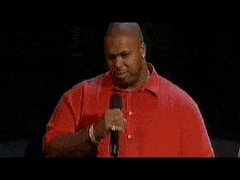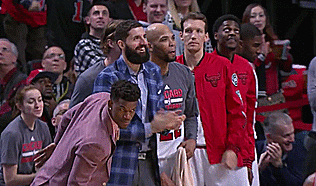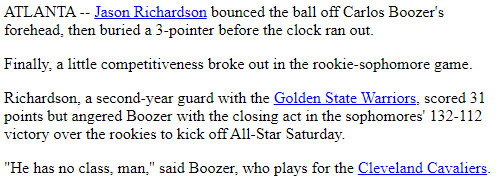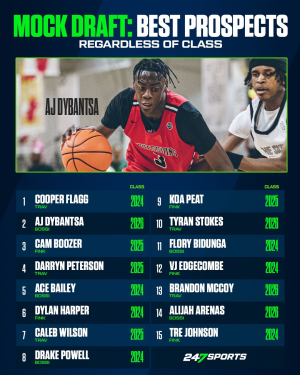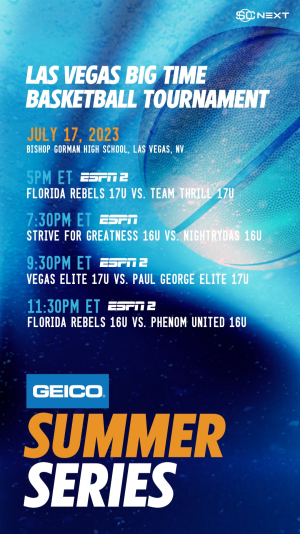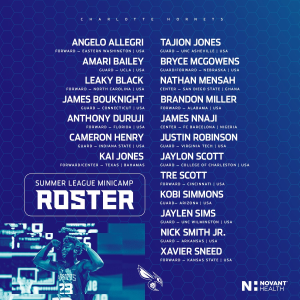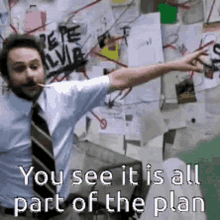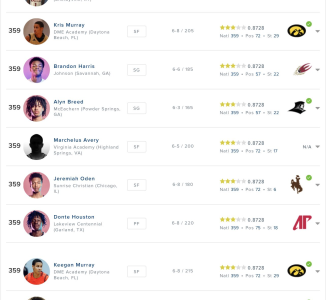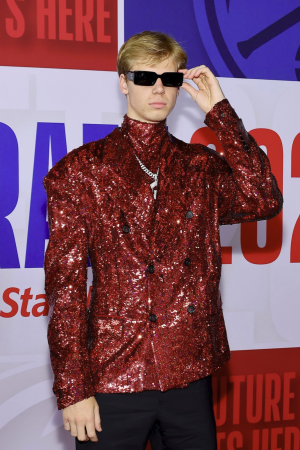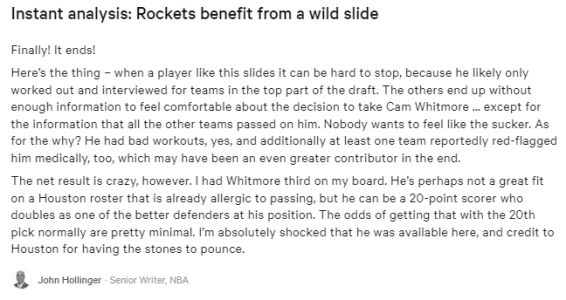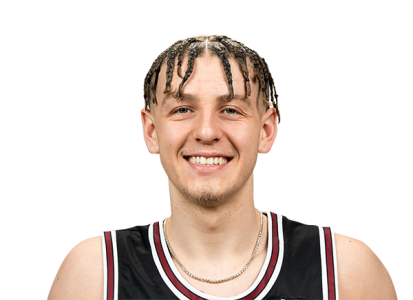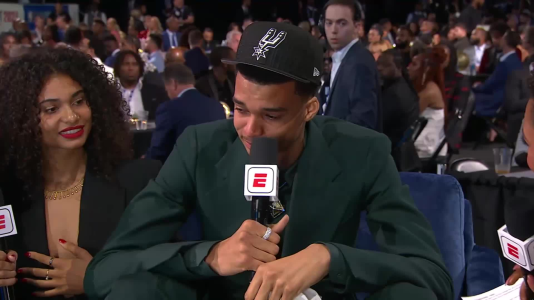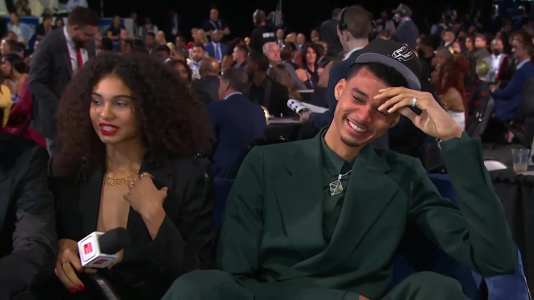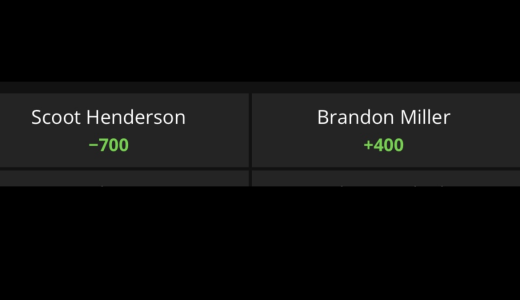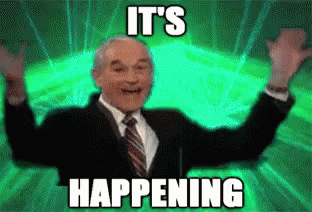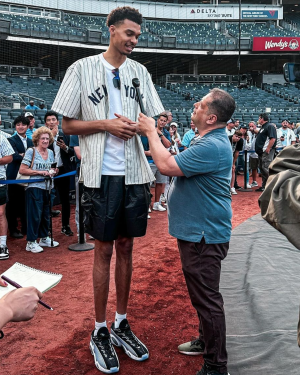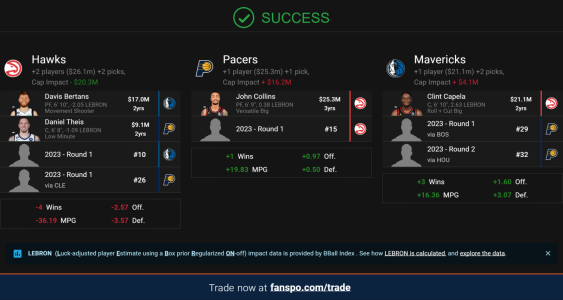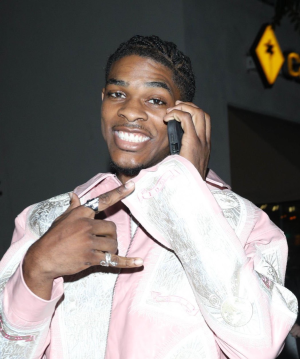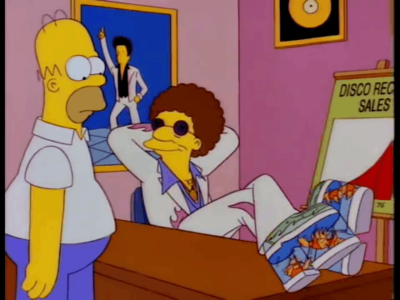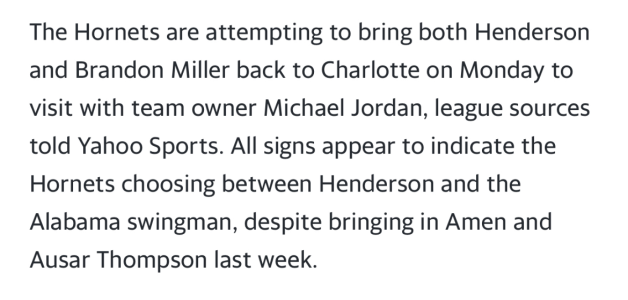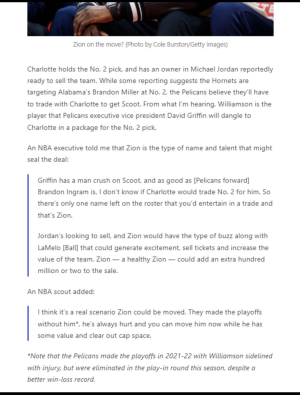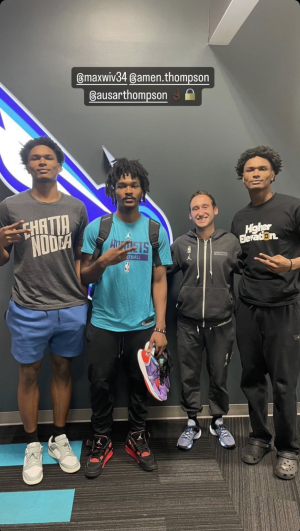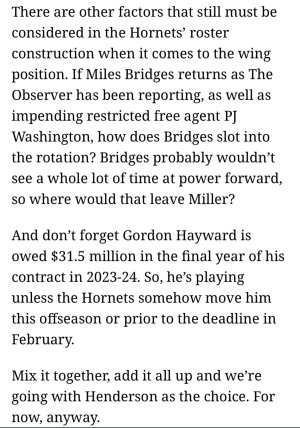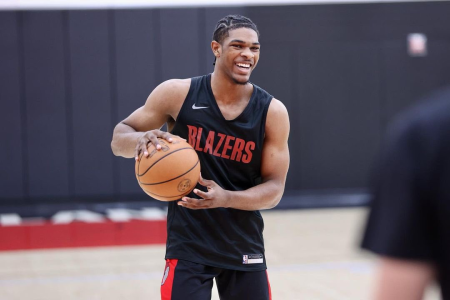- 86,363
- 113,340
- Joined
- Sep 5, 2010
2023 NBA Draft’s Top 20 players, plus two sleepers you need to know
It’s that time again. Time to go back through tape and my in-person notes, break down all the numbers and figure out the 20 or so players in this NBA Draft that I truly believe in.
While one of those names is very, very easy to write down and will be the focus of un petit peu of the pre-draft conversation, getting the rest of the list is the hard part.
I usually focus on a top 20 (with a couple of sleepers thrown in) at this point for two reasons: First, as I’ve mentioned previously, most draft classes end up with about 20 players who end up mattering. (By “mattering,” I mean having rotation-caliber or better careers that extend beyond the gift minutes that come with being a first-round pick.) When evaluating a player, it’s a good mental exercise to figure out if he’s likely to be one of The Twenty.
Second of all, as a practical matter, these are the players we know are actually staying in the draft. I won’t put out a top 75 until mid-June, when everyone is done declaring and portaling and NIL’ing and all the other stuff college underclassmen with fringe NBA prospects are doing these days. (One of the hardest parts of preparing for the draft on the team side is figuring out who will actually be in the draft.)
As far as the quality of this draft, I think it’s somewhere in the middle of the pack overall: Not as good as the 2021 class, certainly, but seemingly much better than what I’ve observed thus far from a notably weak 2024 contingent.
Obviously the top spot is a tremendous prize, as Victor Wembanyama looks like a generational prospect, but things trail off quickly from there. In particular, the mid-to-late lottery looks as weak as it has in years. After the top few spots on the board, it quickly becomes an anything-goes type situation.
A couple of big-picture points to remember: First of all, positions matter. Watch these playoffs, and what do you see? A lot of 6-foot-6 to 6-foot-8 guys soaking up minutes, and a lot of centers getting played off the floor.
You’ll see the same thing in free agency this summer: Two-way wings cost money and/or picks to acquire; centers, not so much. The corollary is that a center has to have a much higher ceiling or much better odds of success than an equivalent wing. Aside from the rock star at No. 1, I only have one other true five in my top 20.
The other thing is to really keep track of age, not class. There are some big discrepancies even among players in the freshman class — one notable one, for instance, is that Brandon Miller is nearly two years older than Cam Whitmore despite both being freshmen this past season.
One thing I always do is rank all players by age first; so this year, all the players born in 2004 go in one bucket, all the 2003s in the next one, etc. Then I come back and put together my entire board. It makes it a lot easier to properly value age distinctions, something that history tells us NBA front offices still don’t do quite enough.
With that said, let’s get to the fun part. Here’s my board (ages listed are as of draft day, June 22):
TIER I: Le Dude
1. Victor Wembanyama, 19 years old, 7-4, C, Metropolitans 92
Really? You don’t say?
Wembanyama is in Anthony Davis–LeBron James territory as a prospect, an absolute can’t-miss guy who destroyed the French league as a teenager. He’s 7-4 with a wingspan that encompasses much of Eurasia, is capable of shooting buttery jumpers after complex dribble moves, hit 83 percent from the line, blocked a shot every 10 minutes and shot a free throw every five.
OK, you really want to nitpick? He’s on the skinny side, to say the least, and that impacts some of what he can do on the block. He doesn’t really punish size mismatches, as he’s mostly just looking to get to his jumper and struggles to establish post position. At times, you’d like to see him be more impactful on the glass, although you look up and a 19.6 rebound rate against grown men is pretty impressive. And while he shoots a lot of 3s, some of which are very difficult attempts, his accuracy remains a work in progress: 28.2 percent this season, 27.5 percent last season.
Finally, there is the issue of his size as a whole and how that impacts his longevity as a pro. You know how many players this tall have played 1,000 career games?
ZERO, that’s how many.
Mark Eaton is the world-record holder for any player 7-3 or taller at 875 games. Ralph Sampson, Rik Smits, Zydrunas Ilgauskas and Arvydas Sabonis never got there. Kristaps Porziņģis, at 402 games, is less than halfway there. We’re dealing with a small sample size, obviously, and other slightly shorter players, such as Kareem Abdul-Jabbar and Dikembe Mutombo, had two-decade careers. But the very height that makes Wembanyama so valuable is also likely to impact his career length.
That said, his team has done a good job of minimizing risk. They aren’t having him pack on extra pounds in the weight room to keep the load light on his lower extremities, and he’s playing only one game a week in France. I worry about his ankles, in particular, because of all the jumpers he takes and the inevitably of him absorbing “landing zone” fouls from challenging defenders — something that already happens frequently in France — but he’s made it through this whole season intact.
OK, now that we’re done poking holes in his draft prospects: This is the best player in the draft, and it’s not even close. Wembanyama is likely an instant star from day one; even if you worry about injuries, 10 years of him will be better than 15 years of anybody else. Nobody else in the draft is doing this:
Or this:
Or this:
Case closed. Let’s move on.
TIER II: Star upside
2. Scoot Henderson, 19, 6-2, PG, G League Ignite
Henderson’s season at G League Ignite wasn’t exactly dominant. In fact, statistically, it wasn’t any better than what he’d done a year earlier as a 17-year-old. Despite his impressive physical tools, Henderson repeatedly settled for pull-up 2s that he converted at a barely adequate rate, shooting just 46.5 percent on 2s in a league with basically no shot blockers. Opponents just went under screens against him and dared him to pull up.
Nonetheless, the tool set here is too enticing to ignore. Henderson is a big guard who can defend up positionally, especially with his superior length (a 6-9 wingspan, highly unusual for a 6-2 guard). While his scoring disappointed, he was a very effective distributor in the G League — almost too unselfish, actually.
It appeared, more than anything, that Henderson threw it into cruise control this year while he waited on the NBA. His extended pre-game workouts on game days and severely diminished steal rate both lent more credence to that idea; it wasn’t quite LaMelo Ball-in-Australia level, but other than the head-to-head matchup against Wembanyama in Las Vegas in October, you never felt like you were seeing him at his best.
Although we’ve been hearing his name for a while, Henderson is still one of the younger players in this draft at 19 years and 3 months and has an obvious development pathway if he can shoot more consistently from the perimeter. He made just 32.4 percent of his rare 3-point attempts and 76.4 percent of his free throws this past season, and there’s a danger that he gets “undered” to death as a pro and turns into Eric Bledsoe. Nonetheless, there is Derrick Rose-type upside here, especially if the shooting comes around.
3. Cam Whitmore, 18, 6-6 Fr. SF, Villanova
I wasn’t initially impressed with Whitmore, who missed the first few weeks of the season and came back in early December. He’s powerful and athletic but heavily dependent on two-foot takeoffs around the basket and has a severe case of dribble blindness. Whitmore averaged a whopping 13 field goal attempts per assist this past season; among legitimate prospects, only the visibly unready GG Jackson was worse.
So what’s he doing this high on my board? A wing with this level of athleticism and scoring ability just can’t be any lower; it’s the most valuable commodity in the game. Whitmore has a pretty ready translation as a “points-and-D” guy who scores at a high level and can also guard elite scorers himself; the question is whether the feel will ever come along for the ride, or if he’s just going to get an ugly 20 every night with Heisman Trophy drives into three people.
Even with the two-foot takeoffs, Whitmore is a load when he goes to the rim: powerful, athletic and nimble. He has a good handle for size and a quick burst when he wants to take off, so he gets into the lane easily. Whitmore scored 26.4 points per 100 possessions in Big East play and shot 55.5 percent on 2s, while still leaving easy money on the table in terms of foul drawing that likely will come soon enough. He’s also a solid 3-point shooter; his windup is a little slow right now, but he has deep range. The next step is to get to a pull-up; once Whitmore starts dribbling, he’s going to the cup (probably to his left).
The underrated part here is the defense. Whitmore has active hands that yielded one of the highest steal rates of any prospect, moves his feet in individual defense and gets way up off the floor contesting shots. Combine that with his July 2004 birthdate, and there is still a lot of time for things to turn further in his favor. And for him to figure out what those other four players on the floor do on offense.
4. Brandon Miller, 20, 6-9 Fr. SF, Alabama
Basketball-wise, Miller might be the safest player on the board after Wembanyama. NBA teams will delve deeply into what transpired off-the-court at Alabama this past season, but as of now, teams don’t seem overly concerned.
The problem is that, in the top five, safe isn’t exactly what you’re going after. Miller is 6-9, a money shooter, can handle the ball, whips left-handed passers to rim runners off the bounce and defends the wing at least somewhat credibly. It’s easy to imagine Khris Middleton or Rashard Lewis-type outcomes for him, where he’s the second-best player on a good team.
It’s just harder to see a leading man. He’s not that level of athlete, finisher or ballhandler, and at 21, he’s a bit older than everyone else in the top 10. Despite his size, Miller is a very ordinary finisher, lacking explosion and craft around the rim and struggling to complete plays against any kind of length. His high dribble also gets exposed at times, especially against smaller defenders, and can get away from him.
Miller can shoot off the catch, on the move or off the dribble, and the threat of his shot opens lanes and stresses defense. A nit-picker would like him to get more air under the ball, but he’s big and gets it away fast. His footwork is so good on the catch that he can easily be weaponized as a pick-and-pop threat, something that’s likely to happen much more at the pro level. It’s just hard to imagine a leading man who can’t create offense inside the arc.
Defensively, Miller moves his feet decently for 6-9, and his upper body should fill out enough to allow him to play more four as he gets older. However, I wouldn’t call him a true switch guy either; after one or two slides, he’ll often leave the barn door open for a blow-by. I would trust him guarding threes and perimeter fours though, and he helps on the glass.
Overall, I’m probably on an island choosing Whitmore’s upside over Miller’s certainty, but I think the age difference here isn’t getting enough attention.
5. Anthony Black, 19, 6-7 Fr. PG, Arkansas
I am possibly irrationally out over my skis here, but I love this guy. Black reminds me of Jason Kidd at times, a big, smart, defensively active guard who impacts winning in so many other areas that the lack of a jump shot becomes secondary. Black is also among the younger players in this cohort, with an early 2004 birthdate, and thus time is on his side when it comes to finding his stroke.
Black is a huge point guard who could potentially also play on the wing but moves his feet well enough on the perimeter that he can legitimately guard the one at the pro level. He combines that with some quick leaping, zipping off the ground to surprise shooters with shot contests and using verticality in the basket area very effectively.
Offensively, I’ve been a big fan of Black all year because he can handle, pass and make correct decisions. His handle can get a little wobbly at times, especially in his right hand, and he made too many turnovers overall, but some of that stems from his limited shooting forcing him to drive into the teeth of the defense.
Black has a slow release, a pronounced ball dip and seemingly not a ton of confidence in the entire enterprise, but we’re not talking about DeAndre Jordan here: Getting his shot to at least a 1-in-3 proposition in a two-year span shouldn’t be a massively daunting task.
If he can do that, his size, feet and IQ should more than take care of the rest and make him a fixture in the league for years.
TIER III: The mystery meat(s)
6. Amen Thompson, 20, 6-7 SF, Overtime Elite
Welcome to the hardest evaluation in the draft. Amen Thompson and his twin brother (see below) have spent the least two years at Overtime Elite, a new program that doesn’t provide us with much of a historical gauge for what type of success will translate to the NBA. The Thompsons are also relatively old for one-and-dones; Amen will be 20.5 years old on draft night, while his twin brother will be (checks notes) 20.5 also.
Most of the players the Thompsons are competing against are at least a year younger; many are two or even three years younger. That they dominate the games in this program, or played against other major high school teams, doesn’t really say much. (The matchup everyone wants, that will never ever happen, is to have Overtime Elite play against Ignite.) There is a fair argument to be made that they should be dominating more, actually.
Overtime Elite played one real game against another professional team, versus the Adelaide 36ers of the Australian NBL in October. They lost, but Amen was the best player on the floor with 17 points, eight rebounds and five assists.
Fortunately, the eye test makes it easy to take the plunge here. Amen is 6-7, can handle the ball, jumps out of the gym and sees the floor. This is the exact thing every team in the league is moving heaven and earth to acquire: elite athletes with size who can handle and pass.
There are nits to pick with Thompson’s need for two-foot takeoffs, his gambling on defense and his lack of a pull-up game. But the biggest issue, by far, is his shot. It was a question when he get to Overtime, and in two years, it hasn’t really improved much. If you think Henderson is going to get “undered,” wait till you see how teams treat this guy. He could just be a 6-7 Rajon Rondo on offense. The fact that he’s been in this program for two years without material improvement in the shooting is troubling too; there’s a chance he’s just Stacey Augmon.
On the other hand, if a team can work with Amen and get his shot anywhere near proficient, he’s the on-ball go-to guy every team craves. At this point in the draft, with no sure things or even quasi-sure things left on the perimeter, it’s worth rolling the dice.
7. Ausar Thompson, 20, 6-7 SF, Overtime Elite
A lot of what applies to Amen Thompson also applies to his twin brother, Ausar. Among the two, Ausar is generally considered the less athletic prospect, but we’re splitting hairs. Statistically, it’s hard to tell the two apart in most areas, to the point that you half-wondered if the scorekeepers randomly assigned stats to alternating Thompsons. Their playing styles are similar as well. The one difference is that Ausar played off the ball more at Overtime, but that distinction is likely to disappear when he’s not on the same team as his brother.
Unfortunately, the similarities include the shooting part, which is just as big a question for Ausar as it is for Amen. When I went to Overtime Elite pro day this fall, it seemed that Amen was slightly further along, but you’d have a tough time proving that from their in-season percentages. Let’s just say neither of them will have panicked defenders flying into the seats on closeouts.
I’ve seen draft boards with several spots separating these two players, but I have a hard time getting there, especially given the gap between here and the next tier. In fact, the sharp move may be to trade down and take Ausar knowing you’re likely getting 99 percent of Amen.
TIER IV: Some good one-and-dones
8. Dereck Lively II, 19, 7-1 Fr. C, Duke
What is the highest you could justify drafting a rim-protecting center who averaged five points a game? This feels about right. Lively’s value is hurt by the fact that he’s a center, not to mention that averaged five points a game. Yes, five.
However, he’s at least the prototype for might be called a “playoff five” as an offensive rim runner who can both protect the rim and guard the perimeter. Lively is 7-1 but has the feet to comfortably defend on the perimeter and showed it on several occasions during Duke’s season. He also has big rim-protection numbers, with a superior block rate to that posted by fellow Duke lottery pick Mark Williams a year earlier — 12.7 percent for Lively, 11.4 percent for Williams.
Lively did this while guarding out on the floor much more ably than Williams too, although it came at a cost: a whopping 8.0 fouls per 100 possessions, compared to 5.1 for Williams.
Additionally, there are flashes of offensive upside. He only made two of his 13 3-point attempts during the season but looked comfortable launching corner 3s before games; this could easily be a point of development in the early part of his career.
Lively has also shown facility as a passer that can give him some added value beyond finishing dunks. Admittedly, some of that comes from a reluctance to shoot — I’m not sure I’ve ever seen a 7-footer kick out more offensive rebounds. Nonetheless, I’m a big believe in bigs who can pass.
Lively comes with other small quibbles. There is no post game at all, and for his size, you’d also like to see more dominance on the glass than he showed as a freshman. All of that pushes him into the late lottery, but of the prospects born in 2004, only Whitmore and Black were more impactful last season.
9. Taylor Hendricks, 19, 6-9 Fr. SF/PF, Central Florida
A one-and-done lottery pick from UCF? Really? Yes, really. Hendricks came in with little help but established his pro bona fides almost immediately, showing the mobility and skill to play mostly on the perimeter despite standing 6-9.
Henricks shot 39.6 percent from 3 last season, but that may overstate things a bit; he only made 78.2 percent from the line and has a leftward lean on his shot while pulling the ball from the left side of his body; that can cause misses to the sides, especially when he’s not shooting with his feet totally set. Nonetheless, he’s going to be a solid perimeter threat at worst and at his size can launch easily over closeouts.
The area in which he’s still lacking is in one-on-one shot creation. While he can get dunks as a rim runner or in transition, Hendricks’ ability to score in mismatches will likely be a work in progress as he enters the league. Scoring on post-ups may similarly be limited until he puts on more weight.
Defense is where the real value lies here. At 6-9, Hendricks is a switchable dream, capable of guarding four positions and probably useful as a small-ball five down the road. He can block shots as a secondary rim protector and keep smaller guards from penetrating past him, forcing them to shoot over his length.
Is all that worth a mid-lottery pick? In other drafts, maybe not, but in this one, it is.
10. Kobe Bufkin, 19, 6-4 So. SG, Michigan
Bufkin isn’t technically a one-and-done, but functionally, he might as well be. He’s the same age as the one-and-dones with a late 2003 birthdate — in fact, he’s younger than several of them — and he hardly played as a freshman at Michigan.
I actually went to Michigan this winter to see Bufkin’s teammate Jett Howard play against Ohio State’s Brice Sensabaugh and left the arena way more impressed with Bufkin. His size may work against him playing the two, but he has very long arms, and there is a decent possibility his combination of handle and passing chops allow him to play point guard full time. He averaged over five assists per 100 possessions last season while mostly playing the two.
A left-hander, Bufkin has a long, loping release that could use a bit of refinement off the dribble, but from a standstill, he can shoot, as an 83.3 percent career mark from the line shows.
Defensively, Bufkin bounces off the floor quickly and can surprise opponents by blocking the shot of bigger players; he also had a high steal rate and held up decently in one-on-one matchups. I don’t see a stopper here, necessarily, but he should be solid. He has a thin frame that will need to fill out, but once he does, his length and leaping should allow him to guard up in switches without getting creamed.
Overall, there is a lot to like here and a lot of potential developmental pathways.
11. Gradey ****, 19, 6-8 Fr. SF, Kansas
**** is huge and can shoot. ‘Nuff said. As a freshman at Kansas, he hit 40.3 percent from 3 and 85.4 percent from the line, with an over-the-head release that he can launch over closing defenders. In fact, he probably left some money on the table by not shooting more from distance than the 10.0 3s per 100 possessions he averaged.
****’s motion is poetry off the catch, but getting into his release off the dribble takes a minute and can get a little awkward, which may inhibit his shot volume at the next level. He also needs to add sidestep 3s to his arsenal rather than always charging toward the cup after a shot fake.
The good news here is that **** has some secondary ways to impact games offensively. He’s big, can run the floor and has at least some passing chops. He won’t be a primary creator, most likely, but his bag isn’t limited to catch-and-shoots either.
Defensively, **** was targeted by opponents to an almost comical extent last season, but his actual defense wasn’t tragic. He can move his feet on the perimeter, has decently fast hands and at 6-8 can challenge shots. He’s going to play angles and surrender a lot of pull-ups, but blow-bys were actually uncommon on the tape. He needs his body to fill out to stop opponents from trucking straight through his chest, but I expect him to be more below average than awful at this end.
12. Jarace Walker, 19, 6-8 Fr. PF, Houston
How much do we trust this guy to be a decent offensive player? Walker’s shooting and ability to stretch the floor as a four are going to be the main value determinant. He made a quasi-respectable 34.3 percent from 3 last season but only hit 66.3 percent from the line. Watching him shoot before an NCAA Tournament game, you could see he really pulls to his left when he shoots, landing a foot or more to the side of his takeoff point. You could practically feel him fighting it on his free throws.
If the shooting comes around, though, the rest is plug-and-play, a P.J. Washington with better defense. Walker is a good athlete who can score in the paint, a decent passer (although sloppy with the ball at times) and a potential small-ball five who might have some utility as a rim runner.
His real value, however, is on the defensive end. Walker is a really active, mobile defender on the perimeter, just tremendously light on his feet for his size, and combines that with chase-down block capability when guards beat him on their initial move. Watching his tape, he sometimes rudely allowed the blow-by just to block the poor sucker from behind. A 6.3 percent block rate isn’t Dereck Lively territory, but it’s pretty awesome for a secondary rim protector playing the four.
It’s not just blocks either. Walker slides his feet, gets his hands on balls and posted a 14.0 percent rebound rate. He’s just a general menace at this end.
Obviously, there are profile similarities to Hendricks above, but I trust Hendricks more offensively, and that makes him the superior pick.
13. Cason Wallace, 19, 6-4 Fr. SG, Kentucky
There is a lot to like here, initially. Wallace put up good stats as a freshman, especially in areas that usually translate like steals and rebounding for his size. (His 3.7 steals per 100 possessions was monstrous, actually.) He’s pretty clearly a plus defender and had moments as an offensive player despite a post-heavy system, and his 3-point shot looks good enough despite ending the year at 34.6 percent. I wouldn’t call him a money shooter or anything, but he’ll be fine.
Add in the trend of Kentucky guards under John Calipari looking much better as pros than they did in college, and you might really have something here, right?
The issue with Wallace — one that scouts related to me as well — is what his medical report from the draft combine will say. Wallace was impacted by several injuries this past season, including a back injury that you don’t usually see with 19-year-olds; at virtually any point in the season, you can see him wrapped up like a mummy while he takes the court.
His defensive clips, in particular, get notably worse as the season goes on, and he started to look very stiff by the end.
Offensively, Wallace had his moments, especially in transition, but could look very passive in the half court. He was only fourth on his team in usage and had entire games where he never touched the paint.
I’ll park Wallace here for now, acknowledging both the medical upside (maybe he’s really better than this if he was hurt all year?) and the obvious downside (is he a ticking time bomb?). If he’s healthy, his defense will be good enough to get him on the court, and his shot is likely just good enough to keep him there.
14. Dariq Whitehead, 18, 6-6 Fr. SF, Duke
We’re getting into gamble territory, and the best gamble left on the board is with Whitehead. He missed the first half of the season with foot surgery and required another operation after the season, so this is another case where the medical report from the combine will be important. Nonetheless, there’s a hidden upside here too: It underscores that he wasn’t quite right physically all season.
Despite his physical condition, Whitehead showed some pro chops in his freshman season, particularly as a shooter. He shoots line drives but has a nice, compact release that should be easily repeatable; I’m not buying him as a 42.9 percent shooter from 3, which is what he shot at Duke, but he’ll be a threat.
Defensively, Whitehead was more uneven. He has a strong frame and was a real presence challenging shots, even if he rarely blocks them. That said, he could be a little slow sliding his feet — was the foot a problem here? — and his rebound rate (6.8 percent) was pretty sad for a player of this size.
Finally, he still needs to improve his processing inside the arc. Again, he may have been limited by injury, but Whitehead also shot 41 percent on 2s with a poor turnover rate. Most of his forays beyond catch-and-shoots quickly did not end well.
The other factor here is an August 2004 birthdate that makes Whitehead the second-youngest college prospect in this draft. Between that and his exalted pedigree entering the season — some had him as the No. 1 player in this class — Whitehead becomes a worthwhile gamble.
15. Noah Clowney, 18, 6-10 Fr. PF, Alabama
Another birth-certificate bet, Clowney was asked to play as a stretch four on one of the best teams in the country despite the fact that he’s not really ready to be a stretch four. At least yet. This is a classic case of a young, thin player still needing to grow into his body and refine some of his movement, but Clowney is long and fairly skilled.
There is a stretch five here several years down the road, but the question is what Clowney can be between now and then. It’s possible he becomes another Jalen Smith, where he doesn’t give you enough offense at the four but isn’t filled out enough physically to play the five.
It’s worth the risk at this point in the draft. Despite his youth and size, Alabama trusted Clowney to guard the perimeter a ton. He has high hips and his first slide isn’t always great, but he could make up ground late and has his size to fall back on. He also had a knack for taking charges, something that makes up for his middling shot-blocking rate (3.4 percent). Clowney also rebounded at a very high level (15.5 percent) despite ample competition for boards on a big Alabama front line and did not have a notably high foul rate.
Offensively, Clowney’s 3-point percentage (28.3 percent) didn’t line up with the eye test. His stroke is pretty fluid, and it seems only a matter of time before he finds the net more frequently. His 64.9 percent mark from the line is equally sobering. Nonetheless, given his youth and smooth release, I think he’s going to be a league-average shooter before long.
Again, at this point in the draft, it’s an upside risk on a player who might bomb. Clowney is extremely unlikely to play meaningful minutes as a rookie, but in a few years, he could be a starter
TIER V: Let’s Get Crazy!
16. Jaime Jaquez Jr., 22, 6-7 Sr. SF, UCLA
There are plenty of reasons to cross out Jaquez. He’s a mediocre long-range shooter, he’s 22 years old, and he struggles against quickness in one-on-one defense on the perimeter. There are bust scenarios here where he can’t shoot enough on one end and gets cooked on the other.
So why I am I buying here? First, I don’t really believe in the other one-and-dones left; as a group, I’m sure a couple of them will hit, but individually, none strike as me as worth selecting in the teens.
Second, Jaquez just knows how to play. That’s not that alluring if you’re picking fourth maybe, but Jaquez has a lot of elite role player characteristics: He’s a good passer with a low turnover rate, has a knack for help defense and fast hands despite being vulnerable individually, rebounds like a four and can take smaller players off the dribble and finish with either hand. It’s possible the 3-point shooting becomes more of a weapon. It’s not like his shot is broken now; it just hasn’t been something he’s needed.
Overall, he’s been one of the most effective non-centers in college basketball over the last three seasons, and his impact is spread roughly equally at both ends. I’m sure he’ll end up going in the second round, but I think he’ll be a steal for whatever team picks him.
17. Bilal Coulibaly, 18, 6-6 SG/SF, Metropolitans 92
There’s a good chance Wembanyama won’t be the only player from the French league taken in the first round. His teammate, Coulibaly, came on late in the year, joining the main club after spending half a season destroying the French “Espoirs” junior league. U.S.-based scouts were upset when Coulibaly hardly played during the team’s two-game tour of Las Vegas in October, but his late-season playing time has made up for lost time.
Coulibaly still struggles with feel and shooting; he’s definitely a work in progress. However, he’s hit 60 percent on 2s in the French league since his call-up with a high free-throw rate, he’s rebounded over 10 percent of missed shots and has shown obvious NBA-caliber athleticism, especially in transition.
His mid-2004 birthdate also puts time on the side of the team drafting him, perhaps even to keep him in France another year. He’s not exactly crushing the league right now, but he’s made enough eye-opening impact plays to believe in him at the NBA level as a wing energy guy at the very least — and possibly as much more a few years down the road.
18. Marcus Sasser, 22, 6-2 Sr. PG, Houston
Short guards have trouble making it as starting-caliber players, but a lot of the ones who do are built like Sasser, with strong frames and broad shoulders that let them use leverage to defend in switches. Sasser can move his feet on the perimeter too; I wouldn’t say he’s elite in this area, but he had a lot of drivers end up in his chest. Sasser’s rate of 3.4 steals per 100 possessions is also elite and helps his pro projection.
Nonetheless, the real selling point here is elite shooting. Sasser shot 38.4 percent from 3 on massive volume (13.7 attempts per 100 possessions); a year earlier, he hit 43.7 percent on a breathtaking 16.5 attempts per 100. With a compact, repeatable motion and deep range, he’ll be a threat to pull up from anywhere and an excellent floor spacer.
He’ll need that shooting aspect, because as a driver and creator, he’s just OK. He draws a lot of fouls with his strong frame, but with four shot attempts for every assist, he’s wired more as a scorer, and he can have trouble finishing against length.
19. Leonard Miller, 19, 6-10 PF, G League Ignite
While Henderson put up meh numbers for most of the year, Miller was genuinely productive for Ignite, reigniting (sorry) scouts’ interest in him after a rough 2022 Hoop Summit and combine. At this point, Miller seems like a plus option; it’s relatively easy to bet on somebody this productive in the G League (19.8 PER in 38 games) as a 19-year-old eventually turning into something as an NBA player.
Miller’s low left-handed release remains unconvincing and will need continued work; he shot 30.4 percent from 3 and 79.2 percent from the line last season. And the question is, if he can’t stretch the floor, is he good enough to put the ball in his hands. While Miller has a good handle for his size and some slashing ability, he doesn’t project as an on-ball player, and he doesn’t have the hops to be a rim runner.
However, Miller rebounds very well (17.7 percent rebound rate in the G League) and offers some versatility as a defender, where he can competently check threes and fours and likely even masquerade as a small-ball five at times.
And hey, maybe the shot straightens out. At his age, crazier things have happened, and if it does, it will unlock a lot for him given his ball skills for his size.
20. Jordan Hawkins, 21, 6-5 Jr. SG, Connecticut
Hawkins may have briefly blown up this spring as the “NCAA Tournament Guy,” and that may yet see him overvalued on draft night. Nonetheless, his credentials as a movement shooter do warrant first-round consideration despite his limitations in other areas.
First of all, if you need to believe in his shot beyond the eye test of a buttery smooth release that looks exactly the same every time, look at his free-throw percentage. That’ a better long-term predictor than 3-point percentage, and Hawkins made 88.7 percent from the stripe last season. He also got up a ton of attempts, which is another strongly positive indicator, launching 13.8 per 100 possessions while rarely dribbling — he just runs around off the ball until it finds him for a catch-and-shoot.
Investing in limited shooters is always slightly more risky because if they aren’t shooting 40 percent, what do they do? But Hawkins is going to be a guy whose shooting threat bends defenses even when he’s running cold, and he drew fouls at a surprisingly high rate with all his running around and some well-timed shot fakes. Inside the arc, he’s still a limited threat, but nobody is drafting this guy to shoot 2s.
As for his defense, it’s actually pretty competent for this ilk of player. Hawkins is 6-5 with decent length and was notably good at slithering through screens off the ball. (He’d be great at guarding himself.) He lacks strength and can be overpowered, but he slides his feet and applies decent ball pressure and contributed on the glass (7.5 boards per 100 possessions). Realistically, he probably projects as a high-end backup, but he’ll have value.
Tier VI: Two Sleepers
21. Trey Alexander, 20, 6-5 So. SG, Creighton
Traveling to college games this year and interrogating NBA scouts, I’d inevitably reach a point where Creighton came up and one of them whispered, “I kind of like Alexander.” While other NBA hopefuls dot the Bluejays roster — center Ryan Kalkbrenner and small forward Arthur Kaluma both have a shot of getting picked if they keep their names in the draft, and guards Ryan Nembhard and Baylor Scheierman also are on NBA radars — Alexander is the one whose skill set translates best to the next level.
Statistically, Alexander shot 41.2 percent from 3 and 82.4 percent from the line, and watching him, you wonder if he can get even better. Alexander has the right depth every time, it’s uncanny; for an elite shooter, an unusual number of his misses are to the sides because his elbow isn’t totally under the ball. He also has a ball dip on his catch that slows him down. He only took 7.8 3s per 100 possessions, which is low for a marksman this good; speeding up his release could jack this number higher.
Alexander is a bit on the small side for an NBA wing and has a thin frame, so that’s going to work against him. The good news is that he can handle and pass, with a very high assist rate for a two; a secondary creator role might not be too much for him. Alexander also scored at a respectable clip inside the arc and had a solid rebound rate for a skinny guard.
Where his size may hurt is on the defensive end, where he just didn’t make a huge impact. He can use his length to contest shots, but the feet only seemed OK, and he wasn’t notably disruptive off the ball. He’ll need to continue to fill out physically and refine his technique at this end, because he’s going to be at a disadvantage most nights.
22. Brandin Podziemski, 20, 6-5 So. SG, Santa Clara
A transfer who hardly played his freshman season for Illinois, Podziemski blew up in the WCC for mid-major Santa Clara. He profiles as an all-offense, no-defense guy whose success will likely be determined by whether he can kinda sorta hold his own on defense or whether he’ll just be totally eviscerated.
There are definite shortcomings here, although you won’t find them in the stats — Podziemski’s rates of steals, blocks and rebounds actually compare quite well with players of far greater pedigree. The tape doesn’t lie, however: Blow-bys were common, and Podziemski will be giving up inches to virtually any wing he checks (I think his listing at 6-5 will be proven generous). The shred of good news is that he does have some late closing ability to rise up and contest or block shots from behind.
Offensively, however, Podziemski can shine as a secondary creator. The lefty is a deadly 3-point shooter (43.8 percent this past season); that may be a slight outlier based on his 77.1 percent free-throw mark, but the eye test is that he is a money shooter reminiscent of Luke Kennard. Podziemski also is a good passer off the dribble who can function in secondary pick-and-rolls.
A guy like this won’t make it without at least one magic trick up his sleeve, and Podziemski has it: an unworldly floater game, perhaps the best of any draft prospect since Trae Young. He launches them from different angles and approaches, needing little room to unleash glorious parabolas that softly splash through the net on angel’s wings; if he outperforms, this part of his game will likely be a huge piece.
It’s that time again. Time to go back through tape and my in-person notes, break down all the numbers and figure out the 20 or so players in this NBA Draft that I truly believe in.
While one of those names is very, very easy to write down and will be the focus of un petit peu of the pre-draft conversation, getting the rest of the list is the hard part.
I usually focus on a top 20 (with a couple of sleepers thrown in) at this point for two reasons: First, as I’ve mentioned previously, most draft classes end up with about 20 players who end up mattering. (By “mattering,” I mean having rotation-caliber or better careers that extend beyond the gift minutes that come with being a first-round pick.) When evaluating a player, it’s a good mental exercise to figure out if he’s likely to be one of The Twenty.
Second of all, as a practical matter, these are the players we know are actually staying in the draft. I won’t put out a top 75 until mid-June, when everyone is done declaring and portaling and NIL’ing and all the other stuff college underclassmen with fringe NBA prospects are doing these days. (One of the hardest parts of preparing for the draft on the team side is figuring out who will actually be in the draft.)
As far as the quality of this draft, I think it’s somewhere in the middle of the pack overall: Not as good as the 2021 class, certainly, but seemingly much better than what I’ve observed thus far from a notably weak 2024 contingent.
Obviously the top spot is a tremendous prize, as Victor Wembanyama looks like a generational prospect, but things trail off quickly from there. In particular, the mid-to-late lottery looks as weak as it has in years. After the top few spots on the board, it quickly becomes an anything-goes type situation.
A couple of big-picture points to remember: First of all, positions matter. Watch these playoffs, and what do you see? A lot of 6-foot-6 to 6-foot-8 guys soaking up minutes, and a lot of centers getting played off the floor.
You’ll see the same thing in free agency this summer: Two-way wings cost money and/or picks to acquire; centers, not so much. The corollary is that a center has to have a much higher ceiling or much better odds of success than an equivalent wing. Aside from the rock star at No. 1, I only have one other true five in my top 20.
The other thing is to really keep track of age, not class. There are some big discrepancies even among players in the freshman class — one notable one, for instance, is that Brandon Miller is nearly two years older than Cam Whitmore despite both being freshmen this past season.
One thing I always do is rank all players by age first; so this year, all the players born in 2004 go in one bucket, all the 2003s in the next one, etc. Then I come back and put together my entire board. It makes it a lot easier to properly value age distinctions, something that history tells us NBA front offices still don’t do quite enough.
With that said, let’s get to the fun part. Here’s my board (ages listed are as of draft day, June 22):
TIER I: Le Dude
1. Victor Wembanyama, 19 years old, 7-4, C, Metropolitans 92
Really? You don’t say?
Wembanyama is in Anthony Davis–LeBron James territory as a prospect, an absolute can’t-miss guy who destroyed the French league as a teenager. He’s 7-4 with a wingspan that encompasses much of Eurasia, is capable of shooting buttery jumpers after complex dribble moves, hit 83 percent from the line, blocked a shot every 10 minutes and shot a free throw every five.
OK, you really want to nitpick? He’s on the skinny side, to say the least, and that impacts some of what he can do on the block. He doesn’t really punish size mismatches, as he’s mostly just looking to get to his jumper and struggles to establish post position. At times, you’d like to see him be more impactful on the glass, although you look up and a 19.6 rebound rate against grown men is pretty impressive. And while he shoots a lot of 3s, some of which are very difficult attempts, his accuracy remains a work in progress: 28.2 percent this season, 27.5 percent last season.
Finally, there is the issue of his size as a whole and how that impacts his longevity as a pro. You know how many players this tall have played 1,000 career games?
ZERO, that’s how many.
Mark Eaton is the world-record holder for any player 7-3 or taller at 875 games. Ralph Sampson, Rik Smits, Zydrunas Ilgauskas and Arvydas Sabonis never got there. Kristaps Porziņģis, at 402 games, is less than halfway there. We’re dealing with a small sample size, obviously, and other slightly shorter players, such as Kareem Abdul-Jabbar and Dikembe Mutombo, had two-decade careers. But the very height that makes Wembanyama so valuable is also likely to impact his career length.
That said, his team has done a good job of minimizing risk. They aren’t having him pack on extra pounds in the weight room to keep the load light on his lower extremities, and he’s playing only one game a week in France. I worry about his ankles, in particular, because of all the jumpers he takes and the inevitably of him absorbing “landing zone” fouls from challenging defenders — something that already happens frequently in France — but he’s made it through this whole season intact.
OK, now that we’re done poking holes in his draft prospects: This is the best player in the draft, and it’s not even close. Wembanyama is likely an instant star from day one; even if you worry about injuries, 10 years of him will be better than 15 years of anybody else. Nobody else in the draft is doing this:
Or this:
Or this:
Case closed. Let’s move on.
TIER II: Star upside
2. Scoot Henderson, 19, 6-2, PG, G League Ignite
Henderson’s season at G League Ignite wasn’t exactly dominant. In fact, statistically, it wasn’t any better than what he’d done a year earlier as a 17-year-old. Despite his impressive physical tools, Henderson repeatedly settled for pull-up 2s that he converted at a barely adequate rate, shooting just 46.5 percent on 2s in a league with basically no shot blockers. Opponents just went under screens against him and dared him to pull up.
Nonetheless, the tool set here is too enticing to ignore. Henderson is a big guard who can defend up positionally, especially with his superior length (a 6-9 wingspan, highly unusual for a 6-2 guard). While his scoring disappointed, he was a very effective distributor in the G League — almost too unselfish, actually.
It appeared, more than anything, that Henderson threw it into cruise control this year while he waited on the NBA. His extended pre-game workouts on game days and severely diminished steal rate both lent more credence to that idea; it wasn’t quite LaMelo Ball-in-Australia level, but other than the head-to-head matchup against Wembanyama in Las Vegas in October, you never felt like you were seeing him at his best.
Although we’ve been hearing his name for a while, Henderson is still one of the younger players in this draft at 19 years and 3 months and has an obvious development pathway if he can shoot more consistently from the perimeter. He made just 32.4 percent of his rare 3-point attempts and 76.4 percent of his free throws this past season, and there’s a danger that he gets “undered” to death as a pro and turns into Eric Bledsoe. Nonetheless, there is Derrick Rose-type upside here, especially if the shooting comes around.
3. Cam Whitmore, 18, 6-6 Fr. SF, Villanova
I wasn’t initially impressed with Whitmore, who missed the first few weeks of the season and came back in early December. He’s powerful and athletic but heavily dependent on two-foot takeoffs around the basket and has a severe case of dribble blindness. Whitmore averaged a whopping 13 field goal attempts per assist this past season; among legitimate prospects, only the visibly unready GG Jackson was worse.
So what’s he doing this high on my board? A wing with this level of athleticism and scoring ability just can’t be any lower; it’s the most valuable commodity in the game. Whitmore has a pretty ready translation as a “points-and-D” guy who scores at a high level and can also guard elite scorers himself; the question is whether the feel will ever come along for the ride, or if he’s just going to get an ugly 20 every night with Heisman Trophy drives into three people.
Even with the two-foot takeoffs, Whitmore is a load when he goes to the rim: powerful, athletic and nimble. He has a good handle for size and a quick burst when he wants to take off, so he gets into the lane easily. Whitmore scored 26.4 points per 100 possessions in Big East play and shot 55.5 percent on 2s, while still leaving easy money on the table in terms of foul drawing that likely will come soon enough. He’s also a solid 3-point shooter; his windup is a little slow right now, but he has deep range. The next step is to get to a pull-up; once Whitmore starts dribbling, he’s going to the cup (probably to his left).
The underrated part here is the defense. Whitmore has active hands that yielded one of the highest steal rates of any prospect, moves his feet in individual defense and gets way up off the floor contesting shots. Combine that with his July 2004 birthdate, and there is still a lot of time for things to turn further in his favor. And for him to figure out what those other four players on the floor do on offense.
4. Brandon Miller, 20, 6-9 Fr. SF, Alabama
Basketball-wise, Miller might be the safest player on the board after Wembanyama. NBA teams will delve deeply into what transpired off-the-court at Alabama this past season, but as of now, teams don’t seem overly concerned.
The problem is that, in the top five, safe isn’t exactly what you’re going after. Miller is 6-9, a money shooter, can handle the ball, whips left-handed passers to rim runners off the bounce and defends the wing at least somewhat credibly. It’s easy to imagine Khris Middleton or Rashard Lewis-type outcomes for him, where he’s the second-best player on a good team.
It’s just harder to see a leading man. He’s not that level of athlete, finisher or ballhandler, and at 21, he’s a bit older than everyone else in the top 10. Despite his size, Miller is a very ordinary finisher, lacking explosion and craft around the rim and struggling to complete plays against any kind of length. His high dribble also gets exposed at times, especially against smaller defenders, and can get away from him.
Miller can shoot off the catch, on the move or off the dribble, and the threat of his shot opens lanes and stresses defense. A nit-picker would like him to get more air under the ball, but he’s big and gets it away fast. His footwork is so good on the catch that he can easily be weaponized as a pick-and-pop threat, something that’s likely to happen much more at the pro level. It’s just hard to imagine a leading man who can’t create offense inside the arc.
Defensively, Miller moves his feet decently for 6-9, and his upper body should fill out enough to allow him to play more four as he gets older. However, I wouldn’t call him a true switch guy either; after one or two slides, he’ll often leave the barn door open for a blow-by. I would trust him guarding threes and perimeter fours though, and he helps on the glass.
Overall, I’m probably on an island choosing Whitmore’s upside over Miller’s certainty, but I think the age difference here isn’t getting enough attention.
5. Anthony Black, 19, 6-7 Fr. PG, Arkansas
I am possibly irrationally out over my skis here, but I love this guy. Black reminds me of Jason Kidd at times, a big, smart, defensively active guard who impacts winning in so many other areas that the lack of a jump shot becomes secondary. Black is also among the younger players in this cohort, with an early 2004 birthdate, and thus time is on his side when it comes to finding his stroke.
Black is a huge point guard who could potentially also play on the wing but moves his feet well enough on the perimeter that he can legitimately guard the one at the pro level. He combines that with some quick leaping, zipping off the ground to surprise shooters with shot contests and using verticality in the basket area very effectively.
Offensively, I’ve been a big fan of Black all year because he can handle, pass and make correct decisions. His handle can get a little wobbly at times, especially in his right hand, and he made too many turnovers overall, but some of that stems from his limited shooting forcing him to drive into the teeth of the defense.
Black has a slow release, a pronounced ball dip and seemingly not a ton of confidence in the entire enterprise, but we’re not talking about DeAndre Jordan here: Getting his shot to at least a 1-in-3 proposition in a two-year span shouldn’t be a massively daunting task.
If he can do that, his size, feet and IQ should more than take care of the rest and make him a fixture in the league for years.
TIER III: The mystery meat(s)
6. Amen Thompson, 20, 6-7 SF, Overtime Elite
Welcome to the hardest evaluation in the draft. Amen Thompson and his twin brother (see below) have spent the least two years at Overtime Elite, a new program that doesn’t provide us with much of a historical gauge for what type of success will translate to the NBA. The Thompsons are also relatively old for one-and-dones; Amen will be 20.5 years old on draft night, while his twin brother will be (checks notes) 20.5 also.
Most of the players the Thompsons are competing against are at least a year younger; many are two or even three years younger. That they dominate the games in this program, or played against other major high school teams, doesn’t really say much. (The matchup everyone wants, that will never ever happen, is to have Overtime Elite play against Ignite.) There is a fair argument to be made that they should be dominating more, actually.
Overtime Elite played one real game against another professional team, versus the Adelaide 36ers of the Australian NBL in October. They lost, but Amen was the best player on the floor with 17 points, eight rebounds and five assists.
Fortunately, the eye test makes it easy to take the plunge here. Amen is 6-7, can handle the ball, jumps out of the gym and sees the floor. This is the exact thing every team in the league is moving heaven and earth to acquire: elite athletes with size who can handle and pass.
There are nits to pick with Thompson’s need for two-foot takeoffs, his gambling on defense and his lack of a pull-up game. But the biggest issue, by far, is his shot. It was a question when he get to Overtime, and in two years, it hasn’t really improved much. If you think Henderson is going to get “undered,” wait till you see how teams treat this guy. He could just be a 6-7 Rajon Rondo on offense. The fact that he’s been in this program for two years without material improvement in the shooting is troubling too; there’s a chance he’s just Stacey Augmon.
On the other hand, if a team can work with Amen and get his shot anywhere near proficient, he’s the on-ball go-to guy every team craves. At this point in the draft, with no sure things or even quasi-sure things left on the perimeter, it’s worth rolling the dice.
7. Ausar Thompson, 20, 6-7 SF, Overtime Elite
A lot of what applies to Amen Thompson also applies to his twin brother, Ausar. Among the two, Ausar is generally considered the less athletic prospect, but we’re splitting hairs. Statistically, it’s hard to tell the two apart in most areas, to the point that you half-wondered if the scorekeepers randomly assigned stats to alternating Thompsons. Their playing styles are similar as well. The one difference is that Ausar played off the ball more at Overtime, but that distinction is likely to disappear when he’s not on the same team as his brother.
Unfortunately, the similarities include the shooting part, which is just as big a question for Ausar as it is for Amen. When I went to Overtime Elite pro day this fall, it seemed that Amen was slightly further along, but you’d have a tough time proving that from their in-season percentages. Let’s just say neither of them will have panicked defenders flying into the seats on closeouts.
I’ve seen draft boards with several spots separating these two players, but I have a hard time getting there, especially given the gap between here and the next tier. In fact, the sharp move may be to trade down and take Ausar knowing you’re likely getting 99 percent of Amen.
TIER IV: Some good one-and-dones
8. Dereck Lively II, 19, 7-1 Fr. C, Duke
What is the highest you could justify drafting a rim-protecting center who averaged five points a game? This feels about right. Lively’s value is hurt by the fact that he’s a center, not to mention that averaged five points a game. Yes, five.
However, he’s at least the prototype for might be called a “playoff five” as an offensive rim runner who can both protect the rim and guard the perimeter. Lively is 7-1 but has the feet to comfortably defend on the perimeter and showed it on several occasions during Duke’s season. He also has big rim-protection numbers, with a superior block rate to that posted by fellow Duke lottery pick Mark Williams a year earlier — 12.7 percent for Lively, 11.4 percent for Williams.
Lively did this while guarding out on the floor much more ably than Williams too, although it came at a cost: a whopping 8.0 fouls per 100 possessions, compared to 5.1 for Williams.
Additionally, there are flashes of offensive upside. He only made two of his 13 3-point attempts during the season but looked comfortable launching corner 3s before games; this could easily be a point of development in the early part of his career.
Lively has also shown facility as a passer that can give him some added value beyond finishing dunks. Admittedly, some of that comes from a reluctance to shoot — I’m not sure I’ve ever seen a 7-footer kick out more offensive rebounds. Nonetheless, I’m a big believe in bigs who can pass.
Lively comes with other small quibbles. There is no post game at all, and for his size, you’d also like to see more dominance on the glass than he showed as a freshman. All of that pushes him into the late lottery, but of the prospects born in 2004, only Whitmore and Black were more impactful last season.
9. Taylor Hendricks, 19, 6-9 Fr. SF/PF, Central Florida
A one-and-done lottery pick from UCF? Really? Yes, really. Hendricks came in with little help but established his pro bona fides almost immediately, showing the mobility and skill to play mostly on the perimeter despite standing 6-9.
Henricks shot 39.6 percent from 3 last season, but that may overstate things a bit; he only made 78.2 percent from the line and has a leftward lean on his shot while pulling the ball from the left side of his body; that can cause misses to the sides, especially when he’s not shooting with his feet totally set. Nonetheless, he’s going to be a solid perimeter threat at worst and at his size can launch easily over closeouts.
The area in which he’s still lacking is in one-on-one shot creation. While he can get dunks as a rim runner or in transition, Hendricks’ ability to score in mismatches will likely be a work in progress as he enters the league. Scoring on post-ups may similarly be limited until he puts on more weight.
Defense is where the real value lies here. At 6-9, Hendricks is a switchable dream, capable of guarding four positions and probably useful as a small-ball five down the road. He can block shots as a secondary rim protector and keep smaller guards from penetrating past him, forcing them to shoot over his length.
Is all that worth a mid-lottery pick? In other drafts, maybe not, but in this one, it is.
10. Kobe Bufkin, 19, 6-4 So. SG, Michigan
Bufkin isn’t technically a one-and-done, but functionally, he might as well be. He’s the same age as the one-and-dones with a late 2003 birthdate — in fact, he’s younger than several of them — and he hardly played as a freshman at Michigan.
I actually went to Michigan this winter to see Bufkin’s teammate Jett Howard play against Ohio State’s Brice Sensabaugh and left the arena way more impressed with Bufkin. His size may work against him playing the two, but he has very long arms, and there is a decent possibility his combination of handle and passing chops allow him to play point guard full time. He averaged over five assists per 100 possessions last season while mostly playing the two.
A left-hander, Bufkin has a long, loping release that could use a bit of refinement off the dribble, but from a standstill, he can shoot, as an 83.3 percent career mark from the line shows.
Defensively, Bufkin bounces off the floor quickly and can surprise opponents by blocking the shot of bigger players; he also had a high steal rate and held up decently in one-on-one matchups. I don’t see a stopper here, necessarily, but he should be solid. He has a thin frame that will need to fill out, but once he does, his length and leaping should allow him to guard up in switches without getting creamed.
Overall, there is a lot to like here and a lot of potential developmental pathways.
11. Gradey ****, 19, 6-8 Fr. SF, Kansas
**** is huge and can shoot. ‘Nuff said. As a freshman at Kansas, he hit 40.3 percent from 3 and 85.4 percent from the line, with an over-the-head release that he can launch over closing defenders. In fact, he probably left some money on the table by not shooting more from distance than the 10.0 3s per 100 possessions he averaged.
****’s motion is poetry off the catch, but getting into his release off the dribble takes a minute and can get a little awkward, which may inhibit his shot volume at the next level. He also needs to add sidestep 3s to his arsenal rather than always charging toward the cup after a shot fake.
The good news here is that **** has some secondary ways to impact games offensively. He’s big, can run the floor and has at least some passing chops. He won’t be a primary creator, most likely, but his bag isn’t limited to catch-and-shoots either.
Defensively, **** was targeted by opponents to an almost comical extent last season, but his actual defense wasn’t tragic. He can move his feet on the perimeter, has decently fast hands and at 6-8 can challenge shots. He’s going to play angles and surrender a lot of pull-ups, but blow-bys were actually uncommon on the tape. He needs his body to fill out to stop opponents from trucking straight through his chest, but I expect him to be more below average than awful at this end.
12. Jarace Walker, 19, 6-8 Fr. PF, Houston
How much do we trust this guy to be a decent offensive player? Walker’s shooting and ability to stretch the floor as a four are going to be the main value determinant. He made a quasi-respectable 34.3 percent from 3 last season but only hit 66.3 percent from the line. Watching him shoot before an NCAA Tournament game, you could see he really pulls to his left when he shoots, landing a foot or more to the side of his takeoff point. You could practically feel him fighting it on his free throws.
If the shooting comes around, though, the rest is plug-and-play, a P.J. Washington with better defense. Walker is a good athlete who can score in the paint, a decent passer (although sloppy with the ball at times) and a potential small-ball five who might have some utility as a rim runner.
His real value, however, is on the defensive end. Walker is a really active, mobile defender on the perimeter, just tremendously light on his feet for his size, and combines that with chase-down block capability when guards beat him on their initial move. Watching his tape, he sometimes rudely allowed the blow-by just to block the poor sucker from behind. A 6.3 percent block rate isn’t Dereck Lively territory, but it’s pretty awesome for a secondary rim protector playing the four.
It’s not just blocks either. Walker slides his feet, gets his hands on balls and posted a 14.0 percent rebound rate. He’s just a general menace at this end.
Obviously, there are profile similarities to Hendricks above, but I trust Hendricks more offensively, and that makes him the superior pick.
13. Cason Wallace, 19, 6-4 Fr. SG, Kentucky
There is a lot to like here, initially. Wallace put up good stats as a freshman, especially in areas that usually translate like steals and rebounding for his size. (His 3.7 steals per 100 possessions was monstrous, actually.) He’s pretty clearly a plus defender and had moments as an offensive player despite a post-heavy system, and his 3-point shot looks good enough despite ending the year at 34.6 percent. I wouldn’t call him a money shooter or anything, but he’ll be fine.
Add in the trend of Kentucky guards under John Calipari looking much better as pros than they did in college, and you might really have something here, right?
The issue with Wallace — one that scouts related to me as well — is what his medical report from the draft combine will say. Wallace was impacted by several injuries this past season, including a back injury that you don’t usually see with 19-year-olds; at virtually any point in the season, you can see him wrapped up like a mummy while he takes the court.
His defensive clips, in particular, get notably worse as the season goes on, and he started to look very stiff by the end.
Offensively, Wallace had his moments, especially in transition, but could look very passive in the half court. He was only fourth on his team in usage and had entire games where he never touched the paint.
I’ll park Wallace here for now, acknowledging both the medical upside (maybe he’s really better than this if he was hurt all year?) and the obvious downside (is he a ticking time bomb?). If he’s healthy, his defense will be good enough to get him on the court, and his shot is likely just good enough to keep him there.
14. Dariq Whitehead, 18, 6-6 Fr. SF, Duke
We’re getting into gamble territory, and the best gamble left on the board is with Whitehead. He missed the first half of the season with foot surgery and required another operation after the season, so this is another case where the medical report from the combine will be important. Nonetheless, there’s a hidden upside here too: It underscores that he wasn’t quite right physically all season.
Despite his physical condition, Whitehead showed some pro chops in his freshman season, particularly as a shooter. He shoots line drives but has a nice, compact release that should be easily repeatable; I’m not buying him as a 42.9 percent shooter from 3, which is what he shot at Duke, but he’ll be a threat.
Defensively, Whitehead was more uneven. He has a strong frame and was a real presence challenging shots, even if he rarely blocks them. That said, he could be a little slow sliding his feet — was the foot a problem here? — and his rebound rate (6.8 percent) was pretty sad for a player of this size.
Finally, he still needs to improve his processing inside the arc. Again, he may have been limited by injury, but Whitehead also shot 41 percent on 2s with a poor turnover rate. Most of his forays beyond catch-and-shoots quickly did not end well.
The other factor here is an August 2004 birthdate that makes Whitehead the second-youngest college prospect in this draft. Between that and his exalted pedigree entering the season — some had him as the No. 1 player in this class — Whitehead becomes a worthwhile gamble.
15. Noah Clowney, 18, 6-10 Fr. PF, Alabama
Another birth-certificate bet, Clowney was asked to play as a stretch four on one of the best teams in the country despite the fact that he’s not really ready to be a stretch four. At least yet. This is a classic case of a young, thin player still needing to grow into his body and refine some of his movement, but Clowney is long and fairly skilled.
There is a stretch five here several years down the road, but the question is what Clowney can be between now and then. It’s possible he becomes another Jalen Smith, where he doesn’t give you enough offense at the four but isn’t filled out enough physically to play the five.
It’s worth the risk at this point in the draft. Despite his youth and size, Alabama trusted Clowney to guard the perimeter a ton. He has high hips and his first slide isn’t always great, but he could make up ground late and has his size to fall back on. He also had a knack for taking charges, something that makes up for his middling shot-blocking rate (3.4 percent). Clowney also rebounded at a very high level (15.5 percent) despite ample competition for boards on a big Alabama front line and did not have a notably high foul rate.
Offensively, Clowney’s 3-point percentage (28.3 percent) didn’t line up with the eye test. His stroke is pretty fluid, and it seems only a matter of time before he finds the net more frequently. His 64.9 percent mark from the line is equally sobering. Nonetheless, given his youth and smooth release, I think he’s going to be a league-average shooter before long.
Again, at this point in the draft, it’s an upside risk on a player who might bomb. Clowney is extremely unlikely to play meaningful minutes as a rookie, but in a few years, he could be a starter
TIER V: Let’s Get Crazy!
16. Jaime Jaquez Jr., 22, 6-7 Sr. SF, UCLA
There are plenty of reasons to cross out Jaquez. He’s a mediocre long-range shooter, he’s 22 years old, and he struggles against quickness in one-on-one defense on the perimeter. There are bust scenarios here where he can’t shoot enough on one end and gets cooked on the other.
So why I am I buying here? First, I don’t really believe in the other one-and-dones left; as a group, I’m sure a couple of them will hit, but individually, none strike as me as worth selecting in the teens.
Second, Jaquez just knows how to play. That’s not that alluring if you’re picking fourth maybe, but Jaquez has a lot of elite role player characteristics: He’s a good passer with a low turnover rate, has a knack for help defense and fast hands despite being vulnerable individually, rebounds like a four and can take smaller players off the dribble and finish with either hand. It’s possible the 3-point shooting becomes more of a weapon. It’s not like his shot is broken now; it just hasn’t been something he’s needed.
Overall, he’s been one of the most effective non-centers in college basketball over the last three seasons, and his impact is spread roughly equally at both ends. I’m sure he’ll end up going in the second round, but I think he’ll be a steal for whatever team picks him.
17. Bilal Coulibaly, 18, 6-6 SG/SF, Metropolitans 92
There’s a good chance Wembanyama won’t be the only player from the French league taken in the first round. His teammate, Coulibaly, came on late in the year, joining the main club after spending half a season destroying the French “Espoirs” junior league. U.S.-based scouts were upset when Coulibaly hardly played during the team’s two-game tour of Las Vegas in October, but his late-season playing time has made up for lost time.
Coulibaly still struggles with feel and shooting; he’s definitely a work in progress. However, he’s hit 60 percent on 2s in the French league since his call-up with a high free-throw rate, he’s rebounded over 10 percent of missed shots and has shown obvious NBA-caliber athleticism, especially in transition.
His mid-2004 birthdate also puts time on the side of the team drafting him, perhaps even to keep him in France another year. He’s not exactly crushing the league right now, but he’s made enough eye-opening impact plays to believe in him at the NBA level as a wing energy guy at the very least — and possibly as much more a few years down the road.
18. Marcus Sasser, 22, 6-2 Sr. PG, Houston
Short guards have trouble making it as starting-caliber players, but a lot of the ones who do are built like Sasser, with strong frames and broad shoulders that let them use leverage to defend in switches. Sasser can move his feet on the perimeter too; I wouldn’t say he’s elite in this area, but he had a lot of drivers end up in his chest. Sasser’s rate of 3.4 steals per 100 possessions is also elite and helps his pro projection.
Nonetheless, the real selling point here is elite shooting. Sasser shot 38.4 percent from 3 on massive volume (13.7 attempts per 100 possessions); a year earlier, he hit 43.7 percent on a breathtaking 16.5 attempts per 100. With a compact, repeatable motion and deep range, he’ll be a threat to pull up from anywhere and an excellent floor spacer.
He’ll need that shooting aspect, because as a driver and creator, he’s just OK. He draws a lot of fouls with his strong frame, but with four shot attempts for every assist, he’s wired more as a scorer, and he can have trouble finishing against length.
19. Leonard Miller, 19, 6-10 PF, G League Ignite
While Henderson put up meh numbers for most of the year, Miller was genuinely productive for Ignite, reigniting (sorry) scouts’ interest in him after a rough 2022 Hoop Summit and combine. At this point, Miller seems like a plus option; it’s relatively easy to bet on somebody this productive in the G League (19.8 PER in 38 games) as a 19-year-old eventually turning into something as an NBA player.
Miller’s low left-handed release remains unconvincing and will need continued work; he shot 30.4 percent from 3 and 79.2 percent from the line last season. And the question is, if he can’t stretch the floor, is he good enough to put the ball in his hands. While Miller has a good handle for his size and some slashing ability, he doesn’t project as an on-ball player, and he doesn’t have the hops to be a rim runner.
However, Miller rebounds very well (17.7 percent rebound rate in the G League) and offers some versatility as a defender, where he can competently check threes and fours and likely even masquerade as a small-ball five at times.
And hey, maybe the shot straightens out. At his age, crazier things have happened, and if it does, it will unlock a lot for him given his ball skills for his size.
20. Jordan Hawkins, 21, 6-5 Jr. SG, Connecticut
Hawkins may have briefly blown up this spring as the “NCAA Tournament Guy,” and that may yet see him overvalued on draft night. Nonetheless, his credentials as a movement shooter do warrant first-round consideration despite his limitations in other areas.
First of all, if you need to believe in his shot beyond the eye test of a buttery smooth release that looks exactly the same every time, look at his free-throw percentage. That’ a better long-term predictor than 3-point percentage, and Hawkins made 88.7 percent from the stripe last season. He also got up a ton of attempts, which is another strongly positive indicator, launching 13.8 per 100 possessions while rarely dribbling — he just runs around off the ball until it finds him for a catch-and-shoot.
Investing in limited shooters is always slightly more risky because if they aren’t shooting 40 percent, what do they do? But Hawkins is going to be a guy whose shooting threat bends defenses even when he’s running cold, and he drew fouls at a surprisingly high rate with all his running around and some well-timed shot fakes. Inside the arc, he’s still a limited threat, but nobody is drafting this guy to shoot 2s.
As for his defense, it’s actually pretty competent for this ilk of player. Hawkins is 6-5 with decent length and was notably good at slithering through screens off the ball. (He’d be great at guarding himself.) He lacks strength and can be overpowered, but he slides his feet and applies decent ball pressure and contributed on the glass (7.5 boards per 100 possessions). Realistically, he probably projects as a high-end backup, but he’ll have value.
Tier VI: Two Sleepers
21. Trey Alexander, 20, 6-5 So. SG, Creighton
Traveling to college games this year and interrogating NBA scouts, I’d inevitably reach a point where Creighton came up and one of them whispered, “I kind of like Alexander.” While other NBA hopefuls dot the Bluejays roster — center Ryan Kalkbrenner and small forward Arthur Kaluma both have a shot of getting picked if they keep their names in the draft, and guards Ryan Nembhard and Baylor Scheierman also are on NBA radars — Alexander is the one whose skill set translates best to the next level.
Statistically, Alexander shot 41.2 percent from 3 and 82.4 percent from the line, and watching him, you wonder if he can get even better. Alexander has the right depth every time, it’s uncanny; for an elite shooter, an unusual number of his misses are to the sides because his elbow isn’t totally under the ball. He also has a ball dip on his catch that slows him down. He only took 7.8 3s per 100 possessions, which is low for a marksman this good; speeding up his release could jack this number higher.
Alexander is a bit on the small side for an NBA wing and has a thin frame, so that’s going to work against him. The good news is that he can handle and pass, with a very high assist rate for a two; a secondary creator role might not be too much for him. Alexander also scored at a respectable clip inside the arc and had a solid rebound rate for a skinny guard.
Where his size may hurt is on the defensive end, where he just didn’t make a huge impact. He can use his length to contest shots, but the feet only seemed OK, and he wasn’t notably disruptive off the ball. He’ll need to continue to fill out physically and refine his technique at this end, because he’s going to be at a disadvantage most nights.
22. Brandin Podziemski, 20, 6-5 So. SG, Santa Clara
A transfer who hardly played his freshman season for Illinois, Podziemski blew up in the WCC for mid-major Santa Clara. He profiles as an all-offense, no-defense guy whose success will likely be determined by whether he can kinda sorta hold his own on defense or whether he’ll just be totally eviscerated.
There are definite shortcomings here, although you won’t find them in the stats — Podziemski’s rates of steals, blocks and rebounds actually compare quite well with players of far greater pedigree. The tape doesn’t lie, however: Blow-bys were common, and Podziemski will be giving up inches to virtually any wing he checks (I think his listing at 6-5 will be proven generous). The shred of good news is that he does have some late closing ability to rise up and contest or block shots from behind.
Offensively, however, Podziemski can shine as a secondary creator. The lefty is a deadly 3-point shooter (43.8 percent this past season); that may be a slight outlier based on his 77.1 percent free-throw mark, but the eye test is that he is a money shooter reminiscent of Luke Kennard. Podziemski also is a good passer off the dribble who can function in secondary pick-and-rolls.
A guy like this won’t make it without at least one magic trick up his sleeve, and Podziemski has it: an unworldly floater game, perhaps the best of any draft prospect since Trae Young. He launches them from different angles and approaches, needing little room to unleash glorious parabolas that softly splash through the net on angel’s wings; if he outperforms, this part of his game will likely be a huge piece.









